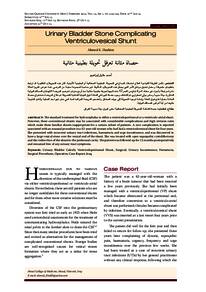Document
Urinary bladder stone complicating ventriculovesical shunt.
Other titles
حصاة مثانة تعرقل تحويلة بطينية مثانية
Publisher
College of Medicine, Sultan Qaboos University.
Gregorian
2014-02
Language
English
English abstract
The standard treatment for hydrocephalus is either a ventriculoperitoneal or a ventriculo-atrial shunt.
However, these conventional shunts may be associated with considerable complications and high revision rates
which make these familiar shunts inappropriate for a certain subset of patients. A rare complication is reported
associated with an unusual procedure in a 42-year-old woman who had had a ventriculovesical shunt for four years.
She presented with recurrent urinary tract infections, haematuria and urge incontinence, and was discovered to
have a large vesical stone over the vesical end of the shunt. She was treated with open suprapubic cystolithotomy
and the redirection of the shunt to the peritoneal cavity. The patient was followed up for 12 months postoperatively
and remained free of any urinary tract symptoms.
Sponsorship
Sultan Qaboos University.
Member of
Resource URL
Arabic abstract
تكمن الطريقة القياسية لعلاج استسقاء الدماغ في التحويلة البطينية الصفاقية أو البطينية الأذينية. لكن هذه التحويلات التقليدية قد ترتبط بتعقيدات ملحوظة ومعدل تعديل مرتفع الأمر الذي يجعل هذه التحويلات المألوفة غير مناسبة لمجموعة معينة من المرضى. هنا نعرض تقريرا لحالة نادرة مرتبطة بأجراء غير معتاد لامرأة تبلغ من العمر 42 عاما لديها تحويله بطينية مثانية منذ أربع سنوات. تعرضت المريضة لالتهابات المسالك البولية المتكررة، بيلة دموية وسلس بولي اضطراري. تم اكتشاف وجود حصاة كبيرة في المثانة فوق النهاية المثانية للتحويلة. تم علاج المريضة باستخراج حصاة المثانة بعملية فتح فوق العانة وإعادة توجيه التحويلة إلى جوف الصفاق. وأخضعت المريضة للمراقبه لمدة اثني عشر شهرا بعد العملية وكانت النتيجة خلوها من أية أعراض للمسالك البولية.
Category
Journal articles

